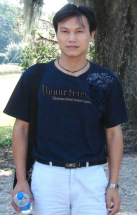报告题目:Spread rates of a juvenile-adult population in constant and temporally variable environments
照 片:

报 告 人:黄启华 教授 西南大学
邀 请 人:吴事良
报告时间:2020年11月9日(周一) 19:00-20:00
腾讯会议ID:142 334 280
报告人简介:黄启华,西南大学环球360会员登录教授,博士生导师。2011年8月在美国 University of Louisiana at Lafayette 获得应用数学博士学位。2011年8月至2016年6月在加拿大University of Alberta生物数学中心从事博士后研究工作,主要合作导师为 Mark Lewis教授 (加拿大皇家科学院院士)。2016年6月通过西南大学人才引进“聚贤工程”计划被特别评聘为教授,并于2016年9月到西南大学工作。主要研究方向为生物数学、偏微分方程和数值分析。科研成果主要发表SIAM Journal on Applied Mathematics、Journal of Mathematical Biology 以及Theoretical Ecology等。目前正主持国家自然科学基金面上项目和重庆市留学人员回国创新支持计划重点项目各一项。
报告摘要:The question of how growth, dispersal, and environmental factors affect the persistence and spread of an invasive species is of great importance in spatial ecology. Motivated by the fact that in a species, different development stages may have different vital rates and dispersal characteristics, we propose and study a reaction-diffusion juvenile-adult model, which is a natural extension of the classical Fisher's equation. We investigate the spread rates of the population if persistent. By comparing our juvenile-adult model with the physically unstructured Fisher model, we find that Fisher equation can be approximated by our juvenile-adult model in several ways. Accordingly, the spreading speed for Fisher's model represents a special case of that for the juvenile-adult model. We analyze how the vital rates and different dispersal abilities between juveniles and adults influence the spreading spread of the structured population, the results indicate that the juvenile-adult model provides more insights into population spread than Fisher equation.We then study a reaction-diffusion juvenile-adult model with temporally periodic coefficients. We develop a novel numerical method to calculate the spreading speed under temporal variability. Finally, we utilize the time-periodic model to understand the spatial spread of a population with separate breeding and non-breeding seasons. In particular, we scrutinize how the seasonal variation in vital rates and dispersal rates, and the duration of the breeding season affect the spreading speed of the population. The theory developed here can provide effective strategies to control the spread of invasive species.